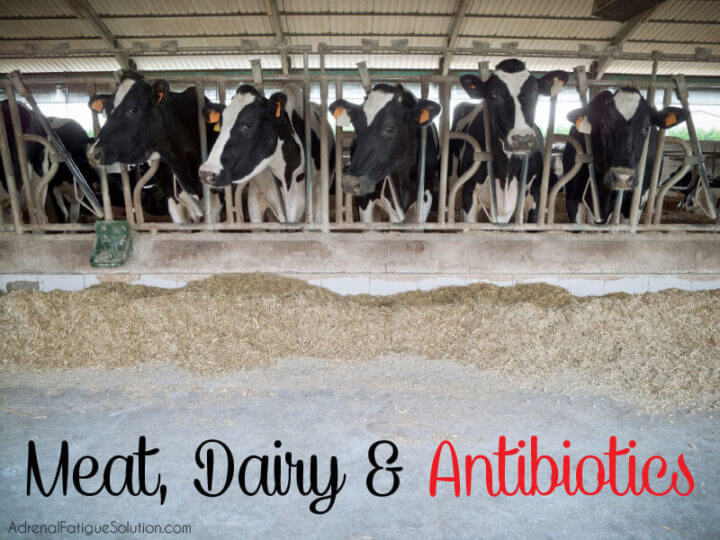When most people think about antibiotics, they usually think of white-coated doctors prescribing sick children and adults with the medication that they need to recover from debilitating bacterial infections. However, there is a mountain of evidence to suggest that antibiotics are massively overprescribed, especially when it comes to viral or fungal infections.
Many of us choose to stay away from antibiotics as much as possible, except in those cases where they are genuinely needed. But we also need to be aware of other sources of antibiotics, besides those given to us on prescription. Recent studies and have demonstrated that society as a whole may be consuming large quantities of antibiotics unwillingly and without even realizing.
This has serious implications for our immune systems, adrenal health, and much more. Antibiotics impair the ‘good bacteria’ which reside in our guts, vital microorganisms that produce vitamins, aid in our digestive processes, support our immune systems and facilitate nutrient absorption. Consuming antibiotics can lead to gut dysbiosis, whereby the balance of your gut flora is disturbed and all these tremendous benefits are suddenly lost. Luckily, with a little awareness and some dietary changes, we can largely avoid these ‘hidden’ antibiotics.
Meat, Dairy & Antibiotics
Where are these hidden antibiotics found? Mostly in meat. Animals such as chickens and cows that are farmed for their meat are supplied with a cocktail of antibiotic medications as a way to keep them as healthy and large as possible. This is a practice that is more common in the US than other countries, and indeed it has been steadily reduced in many areas around the world.
This method of care is seen as a cheap way for the animals to be kept in a good condition during their time alive, which in the case of smaller livestock like chickens can be as little as six weeks. In addition to meat, dairy products have been shown to contain traces of antibiotics too. This, again, is because the milk-producing cows are fed antibiotics to maintain their health and longevity.
On the surface, this process might not seem like a hugely problematic issue. Most of us, whether we eat meat and dairy or not, would not begrudge an animal its good health during their time on the farm.
Things start to get worrying when we hear leading experts in the field speaking about specific risks posed by the continued use of antibiotics. While high-dose, infrequent courses of antibiotics (as prescribed by a doctor during a bacterial infection) serve their purpose extremely well, the way in which livestock are supplied with the medication can have pretty much the opposite effect when filtered through to humans.
Evidence has helped to determine that regular, low doses such as those found in meat or dairy can actually create the ideal environment for the breeding of extremely resistant bacteria. With new generations of bacteria birthing in as little time as twenty minutes, prolonged exposure to low doses of antibiotics that cannot fully kill them off can be very detrimental and encourage the growth of so called ‘mutant’ strains.
Creation of such mutant strains can be a huge problem, as laboratory tests have shown to prove that they can learn to avoid and outsmart even the most powerful of medical drugs. A worrying prospect. Margaret Chan, director of the World Health Organization, has gone as far as to predict that an unchanged antibiotic livestock process could lead to currently harmless ailments such as a gashed knee or strep throat having the potential to cause far greater damage.
We should also be concerned about the effect on our gut flora. Low-dose antibiotics will tend to prevent a healthy balance of bacteria in our intestines. Every year we discover new ways in which these gut flora help us to maintain good health, including our immune system, weight, risk of diabetes, and more. So by constantly suppressing our gut flora, we leave ourselves open to regular infections that can stress the endocrine system, lead to adrenal exhaustion, and indirectly cause a host of other health problems.
What Can We Do?
What does the future look like for the state of livestock farming? Countries like the US and Canada are being encouraged to follow a country like the Netherlands, who in 2008 was the number one user of antibiotics amongst livestock in the entire European Union. The decision was undertaken to drastically cut down on this method, and by 2014 the use of antibiotics in agriculture had declined by a full fifty percent. Crucially, this change was undertaken without any negative impact on production of Dutch meat and dairy goods.
After many years of pressure, the Food and Drug Administration in 2013 announced a series of steps to phase out the mainstream use of antibiotics in livestock. This appears to be a genuine bid to stem the ever-increasing issue of the bacterial resistance that the practice is threatening to cause. The public certainly deserves the right to safely consume meat and dairy without serious risks to their health, and hopefully these measures will quickly spread to other countries that use antibiotics in this way.
In the meantime, there are ways to avoid (or at least reduce) your exposure to these hidden antibiotics. Buying organic will guarantee that no antibiotics have been used to produce your meat or dairy. But you don’t necessarily have to pay up for organic meat. Speak to your local butcher and ask him or her how the animals are raised on his supplier farms. Many higher-quality butchers will only carry meats that are free of antibiotics and growth hormones. If his meats come from farms that use antibiotics or aren’t transparent about their practices, consider switching your allegiance to another butcher.




Leave a Reply